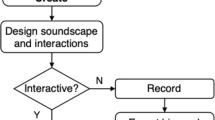Abstract
Listening to music on personal, digital devices whilst mobile is an enjoyable, everyday activity. We explore a scheme for exploiting this practice to immerse listeners in navigation cues. Our prototype, ONTRACK, continuously adapts audio, modifying the spatial balance and volume to lead listeners to their target destination. First we report on an initial lab-based evaluation that demonstrated the approach’s efficacy: users were able to complete tasks within a reasonable time and their subjective feedback was positive. Encouraged by these results we constructed a handheld prototype. Here, we discuss this implementation and the results of field-trials. These indicate that even with a low-fidelity realisation of the concept, users can quite effectively navigate complicated routes.






Similar content being viewed by others
Notes
Garmin International. Garmin StreetPilot c320 car navigation system. http://www.garmin.com/products/sp320/ (last accessed 13/01/2006).
Thales Navigation, Inc. Magellan RoadMat 700 car navigation system. http://www.magellangps.com/en/products/product.asp?PRODID=955 (last accessed 13/01/2006).
TomTom BV. TomTom Go car navigation system. http://www.tomtom.com/products/features.php?ID=0&Language=1 (last accessed 13/01/2005).
Gebhardt N. et al. Irrlicht realtime 3D engine. http://irrlicht.sourceforge.net/ (last accessed 25/02/2005).
Austin C. et al. Audiere audio API. http://audiere.sourceforge.net/home.php (last accessed 25/02/2005).
Map available at http://www.waikatodhb.govt.nz/Media/docs/Campus_Maps/Campus_map_bw.pdf (last accessed 25/02/2005).
Antoine L. Maya 3D graphics & textures. http://www.lemog.club.fr/index.html (last accessed 25/02/2005).
References
Bederson BB (1995) Audio augmented reality: a prototype automated tour guide. Conference companion on human factors in computing systems, pp 210–211
Bull M (2006) Investigating the culture of mobile listening: from Walkman to Ipod. In: O’Hara K, Brown B (eds) Consuming music together: social and collaborative aspects of music consumption technologies (computer supported cooperative work series), vol 35, Chapter 7. Kluwer Academic Publishers, Dordrecht
Brewster S (1993) An evaluation of earcons for use in auditory human-computer interfaces. In: Proceedings of the SIGCHI conference on human factors in computing systems (CHI’93), pp 222–227
Dahley A, Wisneski C, Ishii H (1998) Water lamp and pinwheels: ambient projection of digital information into architectural space. In: Proceedings of the SIGCHI conference summary on human factors in computing systems (CHI’98), pp 269–270
Etter R (2005) Melodious walkabout - implicit navigation with contextualized personal audio contents. In: Adjunct proceedings of the third international conference on pervasive computing, ISBN 3-85403-191-2
Flintham M, et al (2003) Where on-line meets on the streets: experiences with mobile mixed reality games. Proceedings of the conference on human factors in computing systems, pp 569–576
Gaver WW, Smith RB, O’Shea T (1991) Effective sounds in complex systems: the ARKOLA simulation. In: Proceedings of the SIGCHI conference on Human factors in computing systems: Reaching through technology, pp 85–90
Hart SG, Staveland LE (1988) Development of NASA-TLX (Task Load Index): results of empirical and theoretical research, in human mental workload. In: Hancock PA, Meshkati N (eds) 1988, North Holland, Amsterdam, pp 139–183
Holland S, Morse DR, Gedenryd H (2002) AudioGPS: spatial audio navigation with a minimal attention interface. Personal Ubiquitous Comput 6(4):253–259
Ishii H et al (1998) ambientROOM: integrating ambient media with architectural space. CHI 98 conference summary on human factors in computing systems, pp 173–174
Jones M, Bradley G, Jones S, Holmes G (2006) Navigation-by-music: an initial prototype and evaluation. microsoft research international symposium on intelligent environments. Cambridge, UK (in press)
Kray C et al (2003) Presenting route instructions on mobile devices. In: Proceedings of the 8th international conference on Intelligent user interfaces, pp 117–124
May AJ et al (2003) Pedestrian navigation aids: information requirements and design implications. Personal Ubiquitous Comput 7(6):331–338
Nemirovsky P (1999) Aesthetic forms of expression as information delivery units. Masters thesis, Massachusetts Institute of Technology, accessible via http://www.web.media.mit.edu/∼pauln/research/guideshoes/thesis/Thesis.pdf
Pascoe J (2001) Context-aware software. PhD thesis, University of Kent at Canterbury, accessible via http://www.cs.kent.ac.uk/pubs/2001/1390/content.pdf
Rekimoto J, Nagao K (1995) The world through the computer: computer augmented interaction with real world environments. In: Proceedings of the 8th annual ACM symposium on user interface and software technology, pp 29–36
Sawhney N, Murphy A (1996) ESPACE 2: an experimental hyperaudio environment. Conference companion on human factors in computing systems: common ground, pp 105–106
Sawhney N, Schmandt C (2000) Nomadic radio: speech and audio interaction for contextual messaging in nomadic environments. ACM transactions on computer–human interaction (TOCHI), pp 353–383
Shoval S, Borenstein J, Koren Y (1998) Auditory guidance with the NavBelt—a computerized travel aid for the blind. IEEE Trans Syst Man Cybern 28(3):459–467
Strachan S, Eslambolchilar P, Murray-Smith R, Hughes S, O’Modhrain S (2005) GPSTunes: controlling navigation via audio feedback. In: Proceedings of the 7th international conference on human computer interaction with mobile devices & services, pp 275–278
Tran TV, Letowski T, Abouchacra KS (2000) Evaluation of acoustic beacon characteristics for navigation tasks. Ergonomics 43(6):807–827
Warren N, Jones M, Jones S, Bainbridge D (2005) Navigation via continuously adapted music. Exteded Abstracts, ACM conference on human factors and computing systems (CHI ‘05), Portland, Oregon, USA (April 3–7th 2005), 1849–1852, ACM Press, New York
Weiser M and Brown J S. (1995) Designing calm technology. http://www.ubiq.com/hypertext/weiser/calmtech/calmtech.htm (last accessed 25/02/2005)
Williams J, Murray-Smith R (2004) Granular synthesis for display of time-varying probability densities. In: Proceedings international workshop on interactive sonification, Bielefeld, Germany
Author information
Authors and Affiliations
Corresponding author
Rights and permissions
About this article
Cite this article
Jones, M., Jones, S., Bradley, G. et al. ONTRACK: Dynamically adapting music playback to support navigation. Pers Ubiquit Comput 12, 513–525 (2008). https://doi.org/10.1007/s00779-007-0155-2
Received:
Accepted:
Published:
Issue Date:
DOI: https://doi.org/10.1007/s00779-007-0155-2




